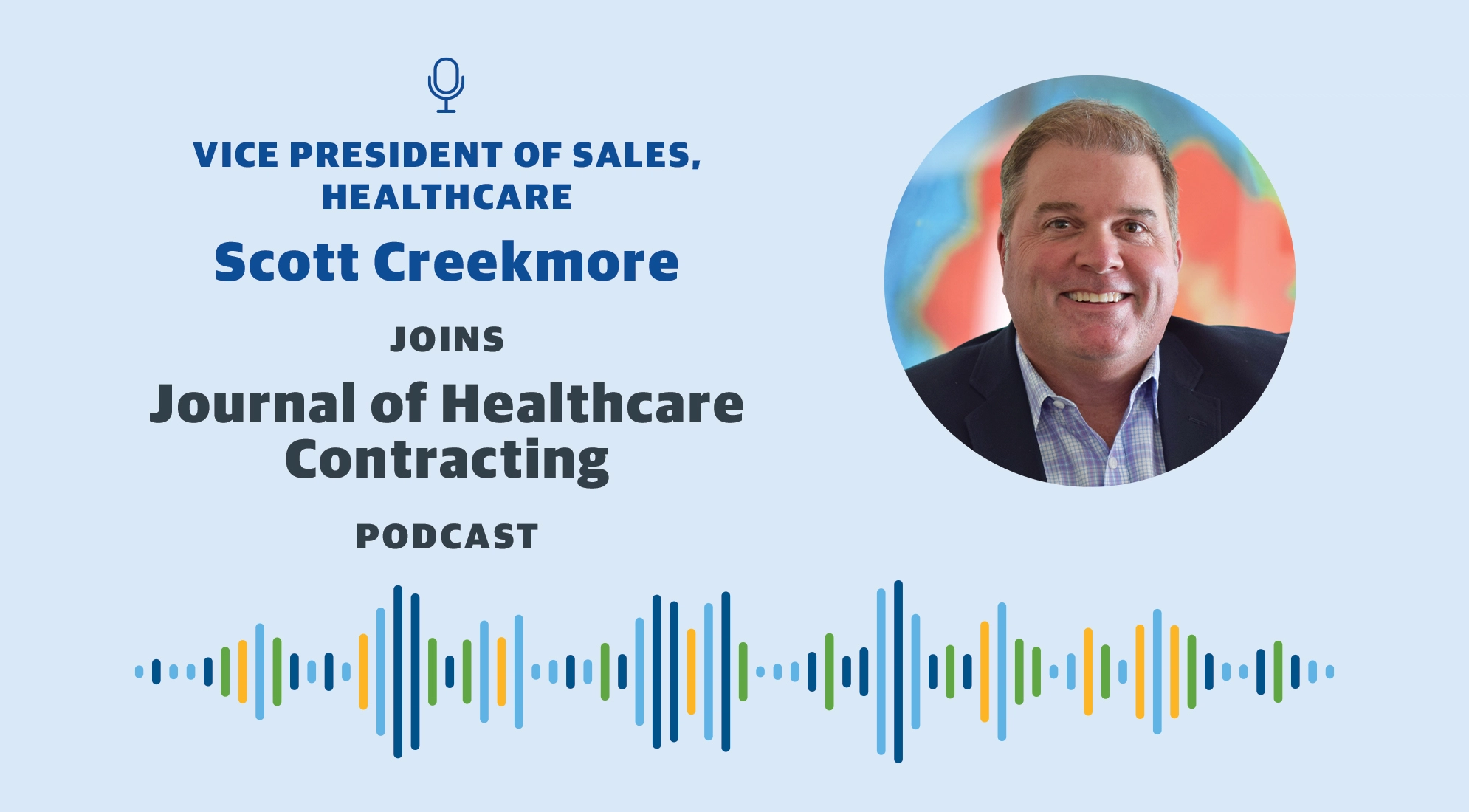
Gordian Vice President of Healthcare Sales, Scott Creekmore, Joins Journal of Healthcare Contracting Podcast
Gordian Vice President of Healthcare Sales, Scott Creekmore, joined the Journal of Healthcare Contracting’s podcast to talk about data-driven, value-based construction procurement and other ways hospitals and healthcare systems can modernize their construction practices. Listen to the entire interview below.
Partial Interview Transcript
John Prichard, Host: What is value-based construction?
Scott Creekmore: Value-based construction is a concept that’s based on value-based healthcare. That’s really where we need to start. Value-based care is a concept where care providers try to increase patient care and lower patient costs, but also allow the hospital to increase profitability, and it uses data, software and analytics to do that. Value-based construction does the same thing. We use data, software and analytics to increase the contractor’s profit by reducing their overhead, which actually will reduce the cost of construction for a health care institution. And it’s supported by data.
Prichard: Interesting. Expand on that for me a little bit. What is data-driven procurement?
Creekmore: There’s been all of these advances in healthcare, with medicine, with the way procedures are done, but really what hasn’t advanced, not just in healthcare, but pretty much holistically, is construction. If you think about it, back in the Neanderthal times, there was a caveman somewhere that wanted a cave painting, and he got three cave painters and said, “How much are you going to charge me to do this?” They had no real way to validate what those costs were.
We still do the same thing. People need something painted and they grab three painters and say, “Give me a cost,” and your costs can be all over the place. Depending on the size of the project, there can be anywhere from 10% to 50% or 60% of a swing. So how do you know that you’re getting value? How do you know that you’re validating the price you’re getting?
What data-driven procurement does is flip the script. It takes the cost of construction and puts that out in the marketplace and says, “We know what these costs should be, and we’ve broken down the material, we’ve identified the labor, we’ve identified the equipment. We know what these costs are. We want you to give us your markup on that.” It allows you to bid one time, and then you have a pool of contractors. [Value-based construction] delivers increased speed to market, it dramatically reduces costs and it gives you much more auditability and transparency.
Prichard: Let’s do a little deeper dive on that. How are you using data, software and analytics to reshape health care construction?
Creekmore: Not a lot has changed in healthcare [construction] procurement over the years. And again, it’s not just in healthcare, but it’s across the board. An analogy that I use, is car buying. Ten years ago, you had to go to this dealership and that dealership, and you just went round and round, and you didn’t know what the costs were. But over the years and especially through the pandemic, we found that we can rely more and more on data.
I can go to an app on my phone and I can select the car that I want to buy. And by this afternoon it can be here. You’re utilizing data; you’re able to identify the costs and keep those costs in control and you’re seeing that more and more across various industries. But construction is one of the industries where it’s really not happening.
If a hospital or help a healthcare agency save money on construction, that directly translates to increased patient care because most hospitals and healthcare organizations run on razor-thin margins. If you can put a process in place that reduces overall construction spending, it can actually help put more money back into the hospital. That’s going to translate to increased patient care. And that’s what we’re really excited about is helping in our own little way increase patient care.
Prichard: That’s really interesting. So much has changed in the last couple years, certainly with the pandemic, and it seems like we have no shortage of natural disasters impacting healthcare facilities and their infrastructure. Can value-based construction to help restore business continuity quickly? And if so, how?
Creekmore: It absolutely can because it relies on data. If you can allow a hospital to do more with less, they’re going be more nimble, they’re going to be more successful. And that’s what data-driven procurement does.
We’ve seen healthcare staff getting stretched thinner and thinner. They’re asked to do more with less time and time again. If you’re looking to do more with less, you always turn to data, always turn to software and this concept, data-driven procurement, will allow them to do that.
Right now, there’s a tremendous amount of facilities backlog. There’s work that wasn’t getting done that still needs to get done. With reduced staff and increased backlog, we’re going to have to be forward-thinking. The old ways of traditional construction procurement are not going to help us. We’re not going to get caught up as fast and we’re not going to get ahead, so we’re going to need to try to do some different things – including data-driven procurement.
Prichard: I couldn’t agree with you more the way we used to do things isn’t going to work in the future. You’re so passionate about value-based care and such a huge part of that is improving outcomes for these hospital systems. How does value-based construction help health systems improve outcomes?
Creekmore: That’s a great question. I became a grandfather about 18 months ago and, honestly, before that I never really thought about healthcare even though I have children. I know that’s kind of short-sighted, but having my grandson made me think about healthcare. I think about the quality of healthcare he’s going to get. I think about those healthcare costs my son and my daughter are going to pay. That’s why I get excited about value-based construction because not only can it deliver savings to a hospital, but you’re able to do things quicker. If a hospital can get an O.R. Suite open sooner, that’s going to directly impact the community. They’re going to be able to offer that service to their communities so much faster, and that really is going to be impactful.
Prichard: Health systems always seem to need to be better and smarter about their financial investments. Speaking directly to healthcare facilities, what are two or three piece of advice you give to these leaders to make smarter financial investments for their healthcare facilities?
Creekmore: First, rely on data. Data is one of those words that it doesn’t matter the setting in which you say it, people always nod their head in agreement. Nobody’s ever going to say, “Oh no, we don’t need any more data.” But when you’re talking about [construction] procurement and we’re saying rely on construction data, take the time to build a dataset that you can share with your contractor, so you can have mutually agreed upon prices and [can] change the dynamic of that relationship. Have your contractor begin to focus on the value that he can bring your organization, not just the price.
Second, improve your relationship with your contractors. If you think about what a contractor has to go through in a traditional, low-bid environment, they have to be lucky. They may look at five different projects and they’re going to be lucky if they win one. That’s four projects that they haven’t won. They still have estimators that they’re paying, they still have an admin that they’re paying. They end up having to dump all of that overhead and all of that profit into that one project. As owners, we really don’t think about that.
We get three bids every time and we award the one contractor and we’re happy. What we don’t ever think about is the two [contractors] that spent the time and spent the money and didn’t get [the job]. They have to make that up somewhere. If you can improve that relationship, if you can set up a data-driven procurement program that eliminates that bidding [for every project] …they [contractors] can lower their overhead costs. And when they lower their overhead costs, maybe the contractor can increase their profits. But in doing that, he’s also going to be able to lower the cost that he’s charging you. It really is a win-win.
The third thing I would say is turn to software; software is critical. We use Excel and we use a lot of different things on a daily basis. You’re going to need something a little more robust because you’re going to need some protection around that, particularly around the data. You’re going to want to make sure that that data is validated, that it’s locked in, so you can trust the pricing that you’re getting.
To sum it up, the three things I’d say would be to rely on data, improve your relationship with your contractor and turn to software to stop thinking about this from a caveman standpoint and start looking to the future.
Share this:






